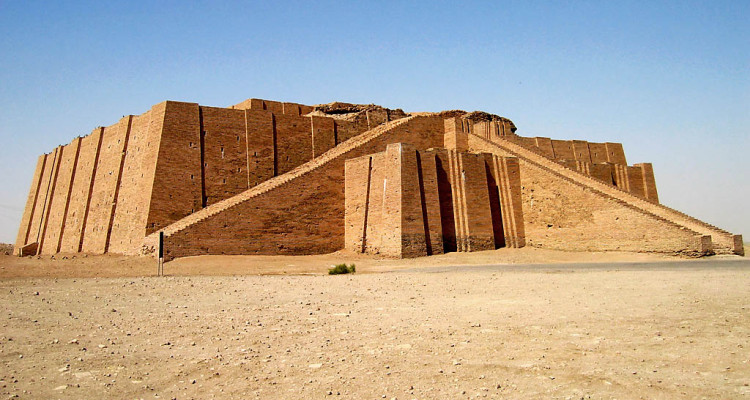The presence of temples as places where people nourish their faith and religion has existed for centuries since the beginning of the earliest civilizations. Since their foundations, temples of any religion have represented places where people could find spiritual and religious comfort. Besides this main function, temples have also played important roles in the management of their cities, impacting their societies in significant ways.

Temples in Ancient Mesopotamia, better known as “community temples,” were basically operated by priests and priestesses that were often younger relatives of the rulers. Their main role was to intervene with the gods for the fortune of their communities through prayers and offerings to their deities. In exchange, the community provided priests with food, drink, and clothing.1 Each temple was dedicated to a major deity, who was the main god of the city. Often the priests serving the temple might have been the former governor of that particular city-state.2 Like many religious organizations today, temple communities also provided help to the people in the community when in need. Temples, for example, used to take care of orphans, supply grain in time of famine, and provide ransom for people who might be captured in battle.3
Mesopotamian temples were not places where people particularly went to worship. They were thought to be the home of the city deity, and for this reason they were equipped like households. They were built with kitchens, tables (in the form of altars), living rooms, and the most important of the rooms, an inner sanctuary where a statue of the major deity stood in one of the building’s walls. Often, these temples used to have staircases to the roof, where rituals and offerings to the deity were performed (e.g. animal sacrifice to feed their god).4

Rams, sheep and doves used to be sacrificed to feed the gods. | Courtesy of National Geographic Spain
In hindsight, the role of temple communities was not limited to the city’s religious life, but they were also large socio-economic organizations.5 Temple communities in Mesopotamia also had an influence in the economy and social living of the cities. Among many of their functions, the operation and maintenance of irrigation systems was one of their highest priorities. They also controlled and managed the industry while developing and manufacturing products that later would be exchanged in foreign trade. Along with this, temples were extensive places for storaging goods and merchandise.6 The records priests and temple staff generated were so extended that some modern economic historians developed the conclusion that the Mesopotamian economy “was dominated by the temple, giving rise to the characterization of ancient Mesopotamia as a ‘temple-state economy.’”7 This was clear to see, since temples were also in charge of the finance of the city. They were in charge of collecting taxes, administrating a system of price control, regulating interest charges, financing foreign trade and legislating all private financial transactions. They also redistributed income by granting money to those in need, and often they also made loans to private individuals.8 Temples also played a role in legal matters and in maintaining social control. Marriages were performed; priests granted divorce, registered births, and administered the law.9
For the importance of their role as a major socio-economic organization as well as their role of mediators between the gods and the city, it can be concluded that Mesopotamian temples possessed a large power among the events happening in the daily life of the individuals living in a particular city. Maybe without the temples, it might have been more difficult for the rulers of the city-states to carry out the functions that these religious organizations used to perform.
- Jerry Bentley, Herbert Ziegler, and Heather Streets Salter, Traditions & Encounters: A Brief Global History Volume 1, 4 edition (McGraw-Hill Education, 2015), 15. ↵
- Richard L. A. Sterba, “The Organization and Management of the Temple Corporations in Ancient Mesopotamia,” The Academy of Management Review 1, no. 3 (1976): 16. ↵
- Bentley, Ziegler, and Streets Salter, Traditions & Encounters: A Brief Global History Volume 1, 15. ↵
- Ronald Wallenfels, World Eras – Vol. 8, Ancient Mesopotamia (Detroit: Gale, 2004), 162. ↵
- Sterba, “The Organization and Management of the Temple Corporations in Ancient Mesopotamia,” The Academy of Management Review, 17. ↵
- Sterba, “The Organization and Management of the Temple Corporations in Ancient Mesopotamia,” The Academy of Management Review, 18. ↵
- Wallenfels, World Eras – Vol. 8, Ancient Mesopotamia, 161. ↵
- Sterba, “The Organization and Management of the Temple Corporations in Ancient Mesopotamia,” The Academy of Management Review, 19. ↵
- Sterba, “The Organization and Management of the Temple Corporations in Ancient Mesopotamia,” The Academy of Management Review, 19. ↵



61 comments
Alexandra Camarena
I loved this article! One of the most interesting things that I read was how these temples were formatted in a way of a house. They were equipped like houses with kitchens and furniture. The other thing that fascinated me was the fact that these temples weren’t primarily used for people to go in and pray but rather homes of a specific deity.
Edgardo Llosa
When I finished reading the article I realiez the importance of this temples in acient Mesopotamia. They carry an important job beyond religion but also economical and educational during this decades. This made the Temples the center of their civilization as a society they depended from the temples to give them structure.
Latha
Its the same way temples developed and were maintained in the Indian subcontinent. The invaders would find it easy to raid temples as they were sure to find goods and wealth there. Conquerors often destroyed precious records and mislead the local population about false excesses in temples!
Daniel Gimena
The functions of temples in early Mesopotamia were huge. It is difficult to think today that only one place in a whole civilization could undertake so many functions and actually manage a society’s operation. Apart from religious affairs, also legal, political, social, agricultural and economic affairs were managed by the temples. Furthermore, marriages, recollection of taxes, etc. also depended on the temple. It can be said without doubt that Temples were the center of a civilization in early Mesopotamia.
Prakshi Kumari
I would wish to read another extended article on this topic. Thanks a lot for this one
Juan Arceo
The temples that were described in this article are not what I initially believed. I would have expected that these temples would simply act like a church as one of its purposes was to serve the main deity of their city but it was more than that. It was built like a house since it was supposed to be comfortable but it was managed like if it was part of the government. Overall, it was pretty interesting to see how temples started off and how they have changed and change for future years.
Amelia Hew
I always thought that temples of the ancient times serves as a place to worship the deities, but apparently its considered a home for the gods. Also the fact that the temple acts as a charity service such as taking care of orphans, providing grains during famine and ransom for those that might been captured in battle really changed my perspective towards ancient temples. It’s no surprise that the temple has an influence in the economy and the social life of the cities, much like the Church during the early centuries. It’s great to learn about the functions of the temple during the early times from the article.
Dalton Moy
To a certain extent, these temples are similar to how churches used to run certain areas. Many records were kept in churches and, of course, charitable functions have always been a large part. Churches usually kept the records for the areas because the governmental power was granted to leaders from the , because I had not realized that early temples were used for functions such as this in ancient times. I had originally thought they were purely for worship. It was actually the exact opposite.
Lamont Traylor
Very well written article, it’s crazy that people have always throughout history built these really extravagant temples for worship. People take their religion so extremely that they are willing to do anything for their faith. Aside from the religious aspect, these temples are marvelous to look at from an architectural stand point and I would really like to know more about how people went about building them.
Valeria Perez
I am always amazed at the amount of complexity ancient civilizations had. I also find it interesting that in several of these ancient civilizations in their religion they allowed priestesses but now I rarely hear about a woman holding a position of this type. I enjoy comparing how each culture had their own special treatment for their religious leaders and the amount of effort they put into building tier temples.